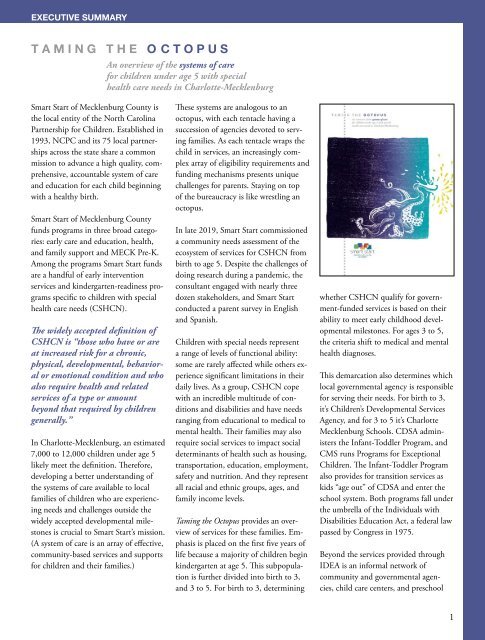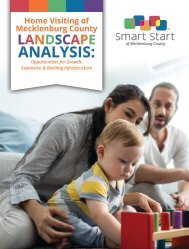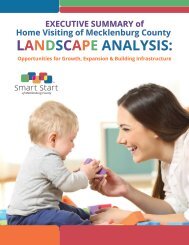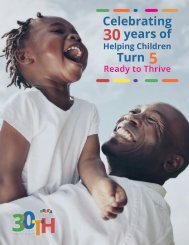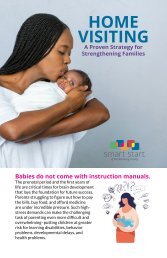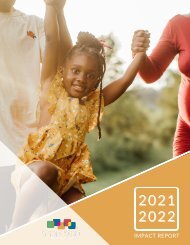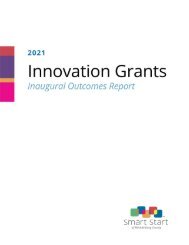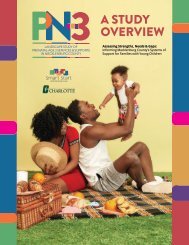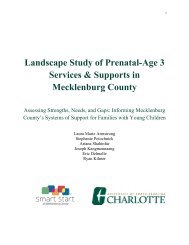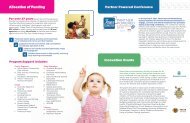Taming the Octopus - Executive Summary
Create successful ePaper yourself
Turn your PDF publications into a flip-book with our unique Google optimized e-Paper software.
EXECUTIVE SUMMARY<br />
T A M I N G T H E O C T O P U S<br />
An overview of <strong>the</strong> systems of care<br />
for children under age 5 with special<br />
health care needs in Charlotte-Mecklenburg<br />
Smart Start of Mecklenburg County is<br />
<strong>the</strong> local entity of <strong>the</strong> North Carolina<br />
Partnership for Children. Established in<br />
1993, NCPC and its 75 local partnerships<br />
across <strong>the</strong> state share a common<br />
mission to advance a high quality, comprehensive,<br />
accountable system of care<br />
and education for each child beginning<br />
with a healthy birth.<br />
Smart Start of Mecklenburg County<br />
funds programs in three broad categories:<br />
early care and education, health,<br />
and family support and MECK Pre-K.<br />
Among <strong>the</strong> programs Smart Start funds<br />
are a handful of early intervention<br />
services and kindergarten-readiness programs<br />
specific to children with special<br />
health care needs (CSHCN).<br />
The widely accepted definition of<br />
CSHCN is “those who have or are<br />
at increased risk for a chronic,<br />
physical, developmental, behavioral<br />
or emotional condition and who<br />
also require health and related<br />
services of a type or amount<br />
beyond that required by children<br />
generally.”<br />
In Charlotte-Mecklenburg, an estimated<br />
7,000 to 12,000 children under age 5<br />
likely meet <strong>the</strong> definition. Therefore,<br />
developing a better understanding of<br />
<strong>the</strong> systems of care available to local<br />
families of children who are experiencing<br />
needs and challenges outside <strong>the</strong><br />
widely accepted developmental milestones<br />
is crucial to Smart Start’s mission.<br />
(A system of care is an array of effective,<br />
community-based services and supports<br />
for children and <strong>the</strong>ir families.)<br />
These systems are analogous to an<br />
octopus, with each tentacle having a<br />
succession of agencies devoted to serving<br />
families. As each tentacle wraps <strong>the</strong><br />
child in services, an increasingly complex<br />
array of eligibility requirements and<br />
funding mechanisms presents unique<br />
challenges for parents. Staying on top<br />
of <strong>the</strong> bureaucracy is like wrestling an<br />
octopus.<br />
In late 2019, Smart Start commissioned<br />
a community needs assessment of <strong>the</strong><br />
ecosystem of services for CSHCN from<br />
birth to age 5. Despite <strong>the</strong> challenges of<br />
doing research during a pandemic, <strong>the</strong><br />
consultant engaged with nearly three<br />
dozen stakeholders, and Smart Start<br />
conducted a parent survey in English<br />
and Spanish.<br />
Children with special needs represent<br />
a range of levels of functional ability:<br />
some are rarely affected while o<strong>the</strong>rs experience<br />
significant limitations in <strong>the</strong>ir<br />
daily lives. As a group, CSHCN cope<br />
with an incredible multitude of conditions<br />
and disabilities and have needs<br />
ranging from educational to medical to<br />
mental health. Their families may also<br />
require social services to impact social<br />
determinants of health such as housing,<br />
transportation, education, employment,<br />
safety and nutrition. And <strong>the</strong>y represent<br />
all racial and ethnic groups, ages, and<br />
family income levels.<br />
<strong>Taming</strong> <strong>the</strong> <strong>Octopus</strong> provides an overview<br />
of services for <strong>the</strong>se families. Emphasis<br />
is placed on <strong>the</strong> first five years of<br />
life because a majority of children begin<br />
kindergarten at age 5. This subpopulation<br />
is fur<strong>the</strong>r divided into birth to 3,<br />
and 3 to 5. For birth to 3, determining<br />
whe<strong>the</strong>r CSHCN qualify for government-funded<br />
services is based on <strong>the</strong>ir<br />
ability to meet early childhood developmental<br />
milestones. For ages 3 to 5,<br />
<strong>the</strong> criteria shift to medical and mental<br />
health diagnoses.<br />
This demarcation also determines which<br />
local governmental agency is responsible<br />
for serving <strong>the</strong>ir needs. For birth to 3,<br />
it’s Children’s Developmental Services<br />
Agency, and for 3 to 5 it’s Charlotte<br />
Mecklenburg Schools. CDSA administers<br />
<strong>the</strong> Infant-Toddler Program, and<br />
CMS runs Programs for Exceptional<br />
Children. The Infant-Toddler Program<br />
also provides for transition services as<br />
kids “age out” of CDSA and enter <strong>the</strong><br />
school system. Both programs fall under<br />
<strong>the</strong> umbrella of <strong>the</strong> Individuals with<br />
Disabilities Education Act, a federal law<br />
passed by Congress in 1975.<br />
Beyond <strong>the</strong> services provided through<br />
IDEA is an informal network of<br />
community and governmental agencies,<br />
child care centers, and preschool<br />
1
programs. They are staffed by special<br />
educators, preschool teachers, physical<br />
<strong>the</strong>rapists, occupational <strong>the</strong>rapists,<br />
speech-language pathologists, social<br />
workers, mental health counselors,<br />
service coordinators, case managers,<br />
care coordinators, family navigators,<br />
interpreters, and o<strong>the</strong>r professionals<br />
who provide services and supports to<br />
<strong>the</strong> child—and often <strong>the</strong> entire family.<br />
At <strong>the</strong> heart of <strong>the</strong> ecosystem is <strong>the</strong><br />
medical home. Novant Health and<br />
Atrium Health are <strong>the</strong> two local linchpins<br />
of <strong>the</strong> medical home. Novant operates<br />
Hemby Children’s Hospital and a<br />
developmental and behavioral pediatric<br />
clinic; Atrium runs Levine Children’s<br />
Hospital and two clinics for developmental<br />
and behavioral pediatrics. Both<br />
hospital systems have neonatal intensive<br />
care units for babies born prematurely<br />
or with birth defects, or who develop an<br />
illness in <strong>the</strong> maternity ward.<br />
.......<br />
Gaps in services, barriers to access<br />
Because <strong>the</strong> systems of care for CSHCN<br />
are based on eligibility requirements,<br />
gaps in services exist for families whose<br />
children may meet <strong>the</strong> definition but<br />
don’t qualify for certain services.<br />
One example is children under age<br />
3 who demonstrate a developmental<br />
delay of less than 30% in one area, or<br />
less than 25% in two or more areas<br />
and <strong>the</strong>refore don’t qualify for CDSA<br />
services. If <strong>the</strong> family doesn’t have an<br />
alternate payer source to seek services<br />
elsewhere, <strong>the</strong> child will likely do<br />
without.<br />
Ano<strong>the</strong>r example is <strong>the</strong> drop-off from<br />
CDSA to CMS. A significant number<br />
of 3-year-olds don’t make <strong>the</strong> transition<br />
to preschool special education. Whe<strong>the</strong>r<br />
<strong>the</strong>y didn’t qualify because <strong>the</strong> school<br />
system’s criteria are more restrictive, or<br />
because <strong>the</strong>ir developmental delays had<br />
“<strong>Taming</strong> <strong>the</strong> <strong>Octopus</strong>” includes a map of <strong>the</strong> systems of care for CSHCN birth to 5.<br />
Download <strong>the</strong> full report at https://bit.ly/3m4PhmN<br />
already been effectively eliminated or<br />
reduced is anyone’s guess. O<strong>the</strong>r factors,<br />
such as reportedly long wait lists for<br />
receiving an evaluation from CMS and<br />
<strong>the</strong> stigma of having a special-ed child,<br />
may also be at play. And CMS staff say<br />
<strong>the</strong>y frequently struggle with getting<br />
parents to return phone calls and participate<br />
in evaluations.<br />
Besides eligibility definitions, lack of<br />
funding also creates gaps in services and<br />
barriers to access—both at <strong>the</strong> institutional<br />
and individual levels. Just as a<br />
family with Medicaid may not be able<br />
to afford a car to drive <strong>the</strong>ir kids to a<br />
child care center, a middle-class family<br />
may not be able to pay for <strong>the</strong> high<br />
deductibles and co-pays that typically<br />
come with commercial health insurance.<br />
Examples of institutional funding<br />
shortages abound during <strong>the</strong> Year of <strong>the</strong><br />
Virus and have even affected Polliwog, a<br />
program designed to fill gaps in services.<br />
(Polliwog’s sole funder is Smart Start.)<br />
Budget cuts necessitated a refocusing<br />
of Polliwog, resulting in <strong>the</strong> elimination<br />
of specialized <strong>the</strong>rapies from <strong>the</strong><br />
program. Limited institutional funding<br />
also creates long wait lists for services.<br />
The N.C. Innovations Waiver through<br />
Medicaid has a delay of up to 10 years.<br />
And <strong>the</strong> wait for ABA <strong>the</strong>rapy for kids<br />
on <strong>the</strong> autism spectrum is said to be as<br />
long as 10 to 15 months.<br />
Finally, social determinants of health<br />
—low income, unstable housing, unsafe<br />
neighborhoods, lack of transportation,<br />
food scarcity, substandard education,<br />
and so on—create disproportionality in<br />
certain racial and ethnic populations.<br />
Lack of transportation and <strong>the</strong> need for<br />
more interpreters were frequently mentioned<br />
as barriers to receiving services,<br />
as well as <strong>the</strong> need for trauma-informed<br />
care.<br />
Intergenerational poverty creates<br />
environments permeated with toxic<br />
stress, which in turn affects early brain<br />
development. From birth to age 5<br />
is a time of extraordinary cognitive,<br />
emotional and social development. The<br />
Adverse Childhood Experiences (ACE)<br />
study has demonstrated that childhood<br />
trauma tends to follow individuals<br />
into adulthood. Adults who experience<br />
significant trauma as children are more<br />
likely to suffer from chronic disease and<br />
mental health disorders.<br />
2
Suggestions for improving <strong>the</strong> system<br />
Smart Start is concerned with ensuring<br />
a connected, equitable system of care for<br />
families of children with special needs,<br />
which requires a focus on supporting<br />
our community partners, engaging<br />
parents, enhancing <strong>the</strong> capacity of <strong>the</strong><br />
current system and considering <strong>the</strong><br />
addition of new frameworks or interventions.<br />
Smart Start should consider<br />
<strong>the</strong> following recommendations:<br />
Explore innovative, crosssector<br />
alternatives to address-<br />
1<br />
ing children’s health and<br />
well-being, such as pediatric accountable<br />
health communities (AHCs), a<br />
collaborative model that integrates<br />
care across health and social service<br />
sectors. Fund service coordinators or<br />
navigators who would be embedded in<br />
pediatric practices or primary care clinics,<br />
in order to link children to behavioral<br />
health and specialized services. The<br />
coordination of <strong>the</strong> screening, referrals<br />
and interventions would reduce disparities<br />
and ensure a structure of support<br />
and continuity of care. A collaborative<br />
system of care for social-emotional,<br />
behavioral and developmental concerns<br />
is beneficial not just for children with<br />
special health needs, but for all children.<br />
Increase <strong>the</strong> availability of<br />
home visiting programs for<br />
pregnant women and new<br />
mo<strong>the</strong>rs. Recent studies indicate that<br />
in North Carolina less than 1% of vulnerable<br />
mo<strong>the</strong>rs receive home visiting—<br />
despite evidence that <strong>the</strong>se types of<br />
interventions should be an integral part<br />
of a larger early childhood system. In<br />
2015, a study commissioned by Smart<br />
Start recommended <strong>the</strong> local implementation<br />
of Child First, a national,<br />
evidence-based home visiting model<br />
serving children with emotional/behavioral<br />
or developmental/learning problems.<br />
Child First recently merged with<br />
Nurse-Family Partnership, expanding<br />
<strong>the</strong> level of support available to families<br />
with a special needs child.<br />
2 4<br />
To maximize Child Find<br />
3 activities and support community<br />
partners, explore <strong>the</strong><br />
feasibility of combining Zfive and<br />
<strong>the</strong> Local Interagency Coordinating<br />
Council into a joint resource with <strong>the</strong><br />
addition of paid staff funded by Smart<br />
Start. There is considerable overlap in<br />
membership between <strong>the</strong> two groups,<br />
and both share common goals, including<br />
a focus on children from birth to<br />
age 5 and participation in Child Find<br />
activities. Yet, participation in both<br />
organizations is said to ebb and flow;<br />
having a paid staff member responsible<br />
for guiding <strong>the</strong> merger and ensuring<br />
its effectiveness may be a solution. The<br />
synergy created from a potential merger<br />
of Zfive and <strong>the</strong> LICC could translate<br />
into a more rigorous system of parent<br />
education and community-based screenings,<br />
likely resulting in reaching those<br />
who remain outside <strong>the</strong> ecosystem.<br />
Create a strong bridge of<br />
engagement with families<br />
to facilitate a parent-toparent<br />
support system. Parents of<br />
children with special health care<br />
needs can experience crippling social<br />
isolation, and research has shown<br />
that <strong>the</strong> two most valuable sources<br />
of support for <strong>the</strong>se families are<br />
information and peer support. The<br />
significance of <strong>the</strong> role of <strong>the</strong> family<br />
is part of federal policy in <strong>the</strong> Developmental<br />
Disabilities Assistance and<br />
Bill of Rights Act, which includes<br />
<strong>the</strong> “family support goals of enabling<br />
families to nurture and enjoy <strong>the</strong>ir<br />
children at home, and preserving,<br />
streng<strong>the</strong>ning, and maintaining <strong>the</strong><br />
family.” Statewide, we have programmatic<br />
supports, training and resources<br />
from UNC- Chapel Hill’s School<br />
of Social Work Family Support<br />
Program and The Family Support<br />
Network of North Carolina. They<br />
provide a parent-to-parent framework<br />
of which Mecklenburg County<br />
has one affiliate, Trusted Parents.<br />
In addition, Smart Start’s Guiding<br />
Parents to Services offers Circle of<br />
Parents Autism for families. Planning<br />
and expansion of parent-toparent<br />
evidence-based models is a<br />
critical need, but an even larger need<br />
is <strong>the</strong> inclusion of parents’ voices.<br />
3
Provide support to <strong>the</strong> two<br />
5 primary service providers,<br />
CDSA and CMS. What can<br />
Smart Start offer to support <strong>the</strong>ir<br />
work? One suggestion is funding<br />
support staff for parent navigation and<br />
for additional staff at CMS to screen<br />
3-year-olds. A system of support and<br />
tracking for preschool-aged children<br />
who receive Part C Transition Services<br />
would determine how many actually<br />
enroll in Programs for Exceptional Children—and<br />
how many do not. Coupled<br />
with strong community partners, such<br />
as CMARC, a navigator would follow<br />
up with families whose children don’t<br />
successfully transition in order to establish<br />
a matrix of causation. Informed<br />
by quantitative and qualitative data,<br />
a navigation model would <strong>the</strong>n be<br />
developed and implemented to ensure<br />
that children who are eligible to enroll<br />
in special-education preschool programs<br />
receive every opportunity to do so.<br />
Build and maintain a central<br />
6 directory of services and<br />
supports to anchor parents<br />
and providers. The directory would<br />
1) disseminate information regarding<br />
early childhood developmental milestones,<br />
2) provide <strong>the</strong> opportunity to complete<br />
<strong>the</strong> Ages and Stages Questionnaire,<br />
and<br />
3) raise awareness of services and supports<br />
available locally.<br />
M E E T A B I & D E M A Y N E<br />
R<br />
achelle Lawrie is mom to two children with special needs: Demayne, 7,<br />
and Abi, 4. Abi likes to put toge<strong>the</strong>r Legos, ride her bike or drive her<br />
electric car, and watch “Little Baby Bum” nursery rhymes on her tablet.<br />
Demayne is fascinated with trains and has an extensive collection of Thomas<br />
& Friends railroad cars. The train enthusiast is also a budding ventriloquist.<br />
Rachelle’s journey as a super-mom began immediately upon Demayne’s<br />
birth. From <strong>the</strong> moment he was born, she suspected something was wrong.<br />
“He was so blue, he was almost gray,” she recalled. “They told me <strong>the</strong>y<br />
were going to take him to do some tests and <strong>the</strong>y would bring him back.”<br />
As <strong>the</strong> hours passed, however, Rachelle grew more and more concerned.<br />
“Finally, a pediatrician came in and explained that he had<br />
a very severe heart murmur,” she said.<br />
That wasn’t all. Some of his organs were in <strong>the</strong><br />
wrong place, or absent altoge<strong>the</strong>r. The next time<br />
Rachelle saw her baby, he was in a makeshift<br />
oxygen tent. The nurses informed her that he<br />
was about to be airlifted to Duke University<br />
Hospital.<br />
“It was very chaotic. It was traumatic. It was<br />
scary. And I didn’t feel like I was getting any information<br />
from <strong>the</strong> hospital. They just told me he had<br />
to be taken away,” she said.<br />
Eventually Demayne would be diagnosed with VACTERL association, a<br />
group of birth defects which tend to co-occur. By his first birthday, he’d spent<br />
four months in <strong>the</strong> hospital and had endured five surgeries.<br />
“The first year was <strong>the</strong> most uncertain,” Rachel said, adding that Demayne<br />
has had 10 surgeries in all, including three open-heart surgeries. Considering<br />
<strong>the</strong> amount of time he spent as an infant with low oxygen, Rachelle is grateful<br />
he doesn’t have any cognitive delay. In fact, he’s always <strong>the</strong> top reader in his<br />
class and earns all A’s in math.<br />
“I’m extremely proud of him because he’s worked exceptionally hard to<br />
get where he is,” she said. “He’s a remarkable little boy.”<br />
When Demayne was about to turn 3, Rachelle was introduced to her<br />
future fiancé, Naji Lee. Within a few months, Naji and Rachelle decided to<br />
have a child toge<strong>the</strong>r. Being pregnant again made Rachelle relive <strong>the</strong> trauma<br />
of Demayne’s birth. Fortunately, her doctor took her PTSD into account and<br />
communicated with her throughout Abi’s birth.<br />
“With Abi, I wasn’t kept in <strong>the</strong> dark about anything. So everything went<br />
really well during her birth—even though I was terrified,” Rachelle said.<br />
Abi’s first year was “very smooth. She crawled on time, she walked on<br />
time. She only crawled for about two weeks and <strong>the</strong>n she figured out walking<br />
was way better.” By her 18-month pediatric appointment, however, Abi was<br />
still nonverbal. The pediatrician referred her to a speech <strong>the</strong>rapist, and over<br />
<strong>the</strong> next year Abi made progress.<br />
But by age 2½, Rachelle noticed Abi’s temper tantrums were much worse<br />
than <strong>the</strong> typically developing 2-year-old. Rachelle talked with her pediatrician<br />
again and received a referral for an evaluation. It would take four-and-a-half<br />
months to get an appointment with a child psychiatrist. The diagnosis was<br />
Autism Spectrum Disorder.<br />
Abi’s psychiatrist referred her to a specialist in applied behavior analysis,<br />
or ABA <strong>the</strong>rapy. It would be ano<strong>the</strong>r four months before she could start<br />
<strong>the</strong>rapy due to <strong>the</strong> long wait list. The wait was worth it, though, as Abi is<br />
now going to ABA for 35 hours a week and has made so much progress she<br />
doesn’t need services through <strong>the</strong> school system.<br />
Demayne is also thriving, especially taking into account all he’s been<br />
through in his short life. He’ll soon be evaluated for autism, and he’s successfully<br />
coping with some o<strong>the</strong>r mental health issues like ADHD and depression.<br />
4
Why Smart Start?<br />
Smart Start of Mecklenburg County was one of 18 counties in North Carolina to<br />
pioneer a new program created in 1993 by <strong>the</strong> General Assembly. By 1997, Smart<br />
Start had expanded to all 100 counties through a network of 75 local partnerships.<br />
In Charlotte-Mecklenburg, Smart Start administers more than $30 million annually<br />
in state, county and private funds to programs serving children under age 5 and<br />
<strong>the</strong>ir families and caregivers.<br />
As a nonprofit organization whose mission is to improve early childhood health,<br />
education and development, and to ensure children are prepared for kindergarten,<br />
Smart Start is uniquely positioned to fill gaps in services and eliminate barriers to<br />
access for families of children with special needs.<br />
Each Child.<br />
Every Neighborhood.<br />
Smart Start of Mecklenburg County<br />
smartstartofmeck.org<br />
(704) 377-6588<br />
601 E. 5th Street, Suite 500<br />
Charlotte, NC 28202<br />
Smart Start of Mecklenburg County partners with 13 local agencies to fund two<br />
dozen local programs. In terms of services for families of children with special<br />
needs, Smart Start currently provides funding to <strong>the</strong> Early Childhood Intervention<br />
program at Novant Health; <strong>the</strong> Polliwog project at Thompson Child & Family<br />
Focus; parent education, early intervention and social support through Charlotte<br />
Speech and Hearing Center; behavioral <strong>the</strong>rapy at Safe Alliance; child care subsidies<br />
administered through Child Care Resources Inc.; home visiting services; and several<br />
preschool and child development programs. In addition, Smart Start administers<br />
<strong>the</strong> MECK Pre-K program for preschoolers aged 4.<br />
As an in-house program, Smart Start offers Guiding Parents to Services, a free program<br />
for parents with children under age 5 who have been diagnosed with Autism<br />
Spectrum Disorder. O<strong>the</strong>r in-house programs supporting all parents include <strong>the</strong><br />
free-book program Dolly Parton Imagination Library and The Basics Mecklenburg,<br />
an early brain development campaign.<br />
North Carolina is recognized nationally as a leader in early childhood health and<br />
development in large measure due to Smart Start. Smart Start of Mecklenburg<br />
County is staffed by highly experienced, passionate professionals with expertise<br />
ranging from strategic business management to community engagement to early<br />
childhood education. Our volunteer board of directors includes elected officials and<br />
distinguished leaders from <strong>the</strong> health, finance, marketing, human resources, academic,<br />
political, literacy, fundraising, legal, and early/special education professions.<br />
<strong>Taming</strong> <strong>the</strong> <strong>Octopus</strong> was researched,<br />
written and designed by Jonathan Scott<br />
(jonscottinc.com).<br />
Published January 2021<br />
As an organization with a long-standing bond to our community, Smart Start has<br />
much to be proud of. Yet we know we can do so much more for <strong>the</strong> families who<br />
most need our help: families who have children with special health care needs. We<br />
not only can invest in local organizations to expand existing services, we can also<br />
create new programs to fill gaps in <strong>the</strong> current systems of care. And we can serve<br />
as a thought leader, convening groups of stakeholders to translate our suggestions<br />
for improvement into a concrete action plan. We believe <strong>the</strong> solutions to systemic<br />
problems can be found within <strong>the</strong> community itself, and we are committed to<br />
beginning a constructive dialog with <strong>the</strong> goal of taming <strong>the</strong> octopus.<br />
5


